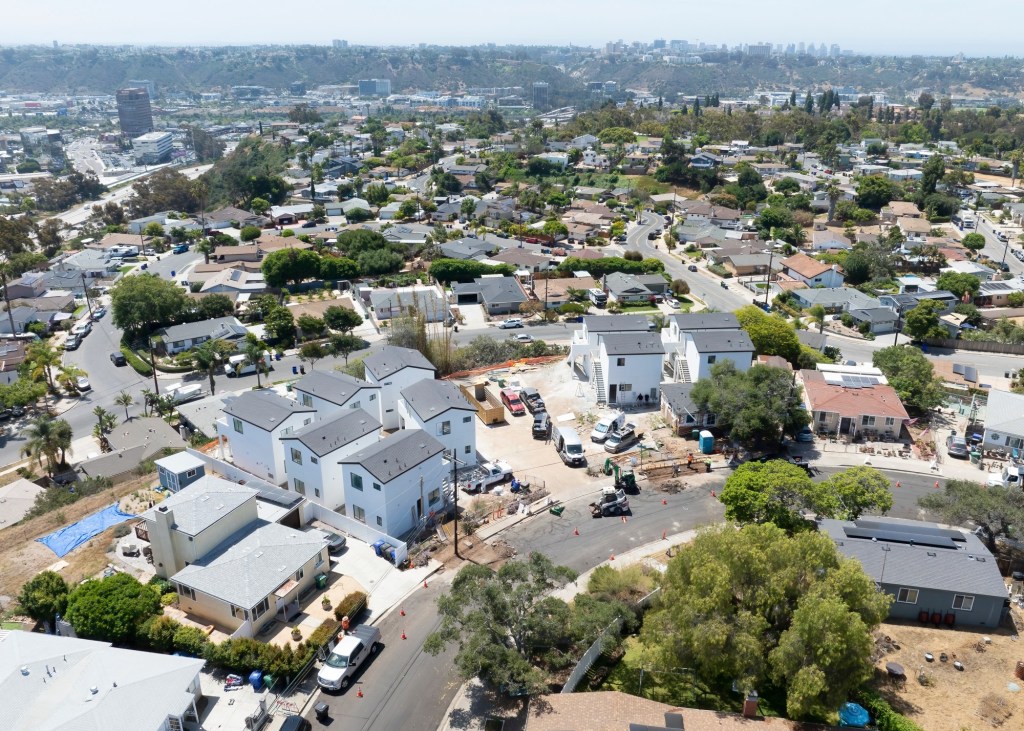San Diego’s momentum approving new homes continued for a second consecutive year in 2024 thanks to a wide variety of incentives, but the city is far off pace for meeting its state housing goals by a 2029 deadline.
A new report shows that the city OK’d 8,782 new homes for construction last year, well above its annual average of 5,100 new home approvals between 2014 and 2022.
The total fell short of the 9,693 homes approved in 2023, which was the highest total in a single year since at least 2005. Officials say they don’t believe the city has approved that many in any single other year since the 1980s.
Despite the two-year surge, San Diego remains far below pace to approve a state-mandated 108,036 new units between 2021 and 2029.
The new numbers bring the city’s four-year total to 34,240, which is 73,796 short of the 2029 goal. That means the city would have to approve an average of 14,760 new homes every year over the next five years to meet it.
“It’s positive, but also a good reminder that there’s a ton of work still to do,” said Councilmember Kent Lee of the new report, which was presented Thursday to the council’s Land Use and Housing Committee.
Councilmember Vivian Moreno was more discouraged.
“This report is sobering,” said Moreno, adding that the numbers would have been far worse without the city’s aggressive incentives. “More people are finding it difficult to find a home to live in that meets their needs.”
Moreno said there’s more to worry about than failing to meet the state goals.
“If we cannot find more ways to build more moderate and affordable homes, our city is going to see more homeless as well as issues with attracting people to come and work here,” she said.
City officials said San Diego had done far better approving new homes in 2024 than other large California cities — at least on a per-capita basis.
San Diego approved 64 new homes for every 10,000 city residents — more than Los Angeles at 45, Fresno at 26, San Jose at 23 and San Francisco at 13.
But critics noted that the bulk of San Diego’s new units are market-rate, and the city is much further behind pace approving subsidized units for moderate-income and low-income residents.
Since the city’s latest state cycle began in 2021, San Diego has approved 28,394 market-rate units — putting it ahead of pace to approve a state-mandated 43,387 such units.
But the city has approved only 743 of a mandated 19,319 moderate-income units, 2,737 of a state-mandated 17,331 low-income units and 2,366 of a state-mandated 27,459 very low income units.
In addition, the bulk of the subsidized units approved last year were in “low-resource” areas that lack quality jobs and other opportunities.
Heidi Vonblum, the city’s planning director, said a forthcoming proposal to streamline approvals of row homes and townhomes could help increase the number of subsidized units approved in high-resource areas.
The city’s aggressive incentive for backyard apartments — formally called accessory dwelling units — played a key role in the city’s total last year.
The city approved a record 2,285 ADUs in 2024, up from 1,909 in 2023 — the first year the city ever broke 1,000. Those 2,285 ADUs accounted for more than a quarter of the total new units approved last year.
Among them are 653 bonus ADUs property owners got to build by making an ADU rent-restricted.
But Moreno noted that the city’s recent rollback of its controversial ADU bonus, which was the most aggressive in the state, will likely shrink the number of ADUs built in coming years.
Two other incentive programs played a key role in the broader 2023 approvals surge, city officials said.
The number of homes approved under the Complete Communities incentive — which lets developers build many more units than the underlining zoning would otherwise allow — has skyrocketed from 170 in 2022 to 1,131 in 2023 and to 1,917 in 2024.
Officials also pointed to the city’s density bonus program, which also allows more units than a property’s zoning otherwise would. That program accounted for 2,619 units, down from a record 3,530 last year.
Neighbors for a Better San Diego, a group that represents mostly single-family homeowners and opposes nearby higher-density development, criticized the report for not tracking how many homes get demolished to make way for new projects.
Mayor Todd Gloria noted that most of the new homes are close to transit. Since 2021, 86% of new units approved by the city are near transit. When only subsidized units are considered, the share rises to 90%.
“We’re not just building more homes, but building them in the right places — near jobs, schools, transit, and opportunity,” Gloria said.
Originally Published: October 9, 2025 at 6:50 PM PDT
